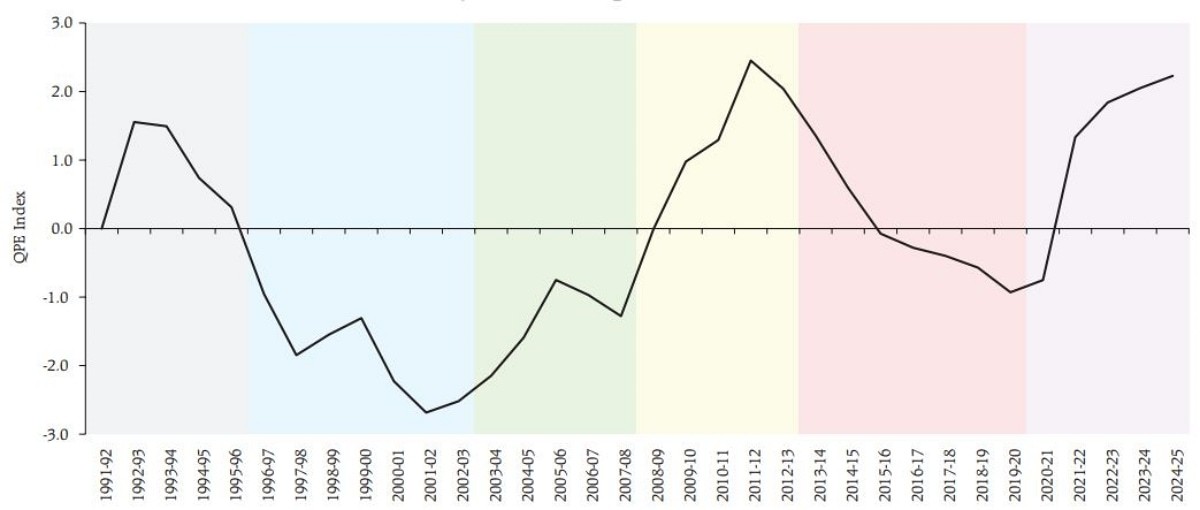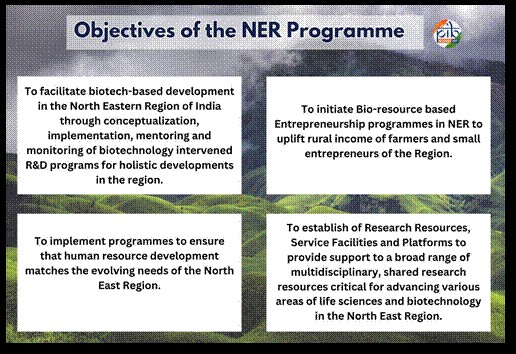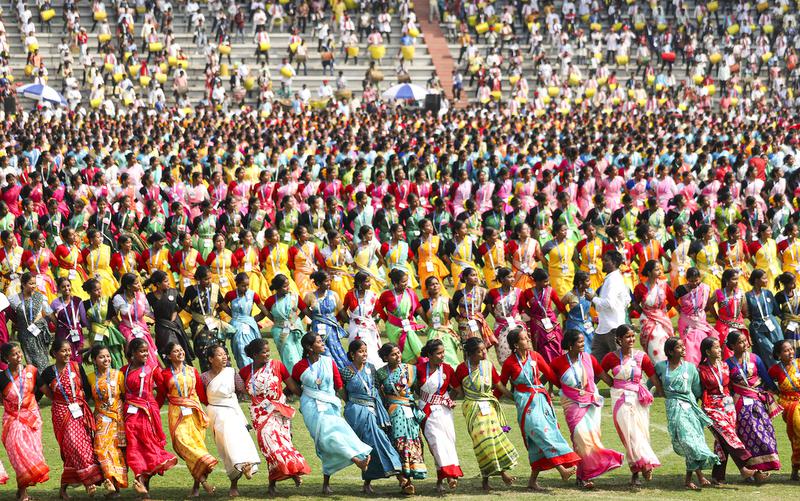Quality of Public Expenditure (QPE) Index

- 25 Feb 2025
In News:
The Quality of Public Expenditure (QPE) Index, developed by the Reserve Bank of India (RBI), measures how efficiently public funds are allocated and utilized by the Central and State governments. Unlike traditional fiscal measures that focus on total expenditure, the QPE Index assesses the composition and developmental impact of government spending, emphasizing long-term economic growth and social development.
Key Components of the QPE Index
Indicator What it Measures Significance
Capital Outlay to GDP Ratio - Share of GDP spent on physical infrastructure - Higher ratio = better quality of expenditure
Revenue Expenditure to Capital Outlay Ratio - Relative spending on salaries, pensions vs. asset creation - Lower ratio = better efficiency
Development Expenditure to GDP Ratio - Spending on education, healthcare, R&D, infrastructure - Higher ratio = enhanced productivity
Development Expenditure as % of Total Expenditure - Proportion of total expenditure directed to development sectors - Higher share = improved allocation
Interest Payments to Total Expenditure Ratio - Financial burden from past borrowings - Lower ratio = better fiscal health
Evolution of Public Expenditure (1991–2025)
- 1991–1997(Early liberalization):
- Slight improvement at Centre; states faced fiscal pressure.
- Public investment declined due to focus on fiscal deficit reduction.
- 1997–2003:Decline in QPE due to Fifth Pay Commission, rising interest burden, dominance of revenue expenditure.
- 2003–2008(FRBM Era):
- Fiscal Responsibility and Budget Management (FRBM) Act, 2003 improved fiscal discipline.
- States gained from higher tax devolution; capital spending rose.
- Growth momentum sustained until the 2008 Global Financial Crisis (GFC).
- 2008–2013(GFC response):
- Stimulus spending initially boosted development but later widened fiscal deficits.
- Spending quality eroded over time.
- 2013–2019(GST & 14th Finance Commission):
- 14th Finance Commission (2015) increased states' tax share to 42%, improving state-level development spending.
- GST rollout (2017) benefited states more than Centre initially, stressing Centre’s finances.
- 2019–2025(COVID-19 & Recovery):
- Pandemic-induced fiscal stimulus reduced QPE temporarily.
- Post-pandemic recovery led by record capital expenditure boosted infrastructure, improving QPE.
- By FY 2024–25, India's QPE reached its highest level since 1991 reforms.
Recent Trends in Public Expenditure (as per Economic Survey 2024–25 & Budget 2025–26)
- Capital expenditure (Capex) rose 8.2% YoY.
- Revenue expenditure (primarily by states) increased 12% YoY.
- FY 2025–26 Budget allocated ?11.21 lakh crore for Capex (3.1% of GDP).
- Capex to GDP ratio increased from 1.5% in 2000 to 2.5% in 2023.
- Revenue expenditure to Capex ratio improved from 8:1 in 2000 to 5:1 in 2023.
- Development expenditure rose from 6% to 8% of GDP between 2000–2023.
- Interest payments declined from 25% to 20% of total expenditure in the same period.
Why Quality of Public Expenditure Matters
- Governments use citizens’ money (via taxes or borrowing). Efficient use ensures better socio-economic outcomes.
- High QPE means greater focus on productive investment over populist spending (freebies, subsidies).
- Better QPE leads to:
- Higher GDP growth (average 6.5% annually since 2000).
- Improved infrastructure and service delivery.
- Enhanced social indicators like literacy (77.7% in 2023) and life expectancy (70 years).
Challenges Affecting Public Expenditure Quality
- Persistent revenue deficits (3.3% of GDP in 2023) limit fiscal space for Capex.
- Rising populism: Loan waivers, cash handouts, free electricity.
- Welfare scheme inefficiencies: Leakages in MGNREGA, PDS.
- Debt servicing: High interest payments constrain spending.
- Inter-state disparities: Unequal fiscal capacity hampers balanced development.
Way Forward
- Boost Capex to over 3% of GDP to enhance infrastructure-led growth.
- Rationalize subsidies via Direct Benefit Transfers (DBT).
- Strengthen fiscal federalism through equitable devolution and performance-based grants.
- Leverage technology for transparent and outcome-based expenditure tracking.
- Reform FRBM Act:
- Focus on debt-to-GDP targets.
- Introduce flexibility in deficit norms during crises.
Biotechnology and Bioeconomy in North East India

- 25 Feb 2025
In News:
The North Eastern Region (NER) of India, endowed with rich biodiversity, cultural heritage, and indigenous knowledge, is undergoing a transformation through biotechnology-led initiatives. The Department of Biotechnology (DBT) under the Ministry of Science and Technology is spearheading this change to harness the region’s biological resources for inclusive and sustainable development.
Biotechnology: Definition and Types
Biotechnology involves the use of biological systems or organisms to develop products and technologies that improve healthcare, agriculture, industry, and the environment.
Types of Biotechnology:
- Medical Biotechnology – Vaccines, gene therapy, diagnostics.
- Agricultural Biotechnology – Pest-resistant crops, high-yield seeds, and sustainable agriculture.
- Industrial Biotechnology – Biofuels, biodegradable plastics, enzyme-based processes.
- Environmental Biotechnology – Waste treatment, pollution control, and bioremediation.
Why North East India is Ideal for Biotech Development
- Biodiversity Hotspot: Home to 8,000+ plant species, including 850+ medicinal plants and agro-climatic diversity.
- Indigenous Knowledge: Rich traditional practices in herbal medicine and organic farming.
- Agri-Biotech Potential: Ideal for medicinal crops, essential oils, and organic produce.
- Industrial Opportunity: Scope for biofuel production, value-added food processing, and pharmaceutical industries.
Key DBT Programmes and Initiatives in the North East
- DBT North Eastern Programme
- Since 2010, 10% of DBT’s annual budget is dedicated to NER.
- Focus: R&D, education, infrastructure, entrepreneurship, and employment generation in biotechnology.
- Twinning R&D Programme (2010–11)
- Promotes collaborative biotech research between NER and national institutes.
- Over 65 institutional partnerships, supporting 650+ projects and benefiting ~2,500 researchers/students.
- Biotech Hubs Network (Since 2011)
- 126 Biotech Hubs established across universities and colleges.
- Phase II supports 54 hubs for focused research on local issues.
- BLiSS (Biotech Labs in Senior Secondary Schools): Started in 2014 to introduce biotechnology at the school level.
- Visiting Research Professorship (VRP) Programme:Launched in 2015 to utilize the expertise of top scientists for NER biotechnology development.
- Chemical Ecology Programme (2015): Collaborative training by NCBS, UAS, and IISc for Ph.D. scholars in the field of chemical ecology.
- Genomics Training Programme (2016):Conducted by DBT-NIBMG, Kalyani, for biomedical researchers in the region.
Agri-Biotech and Livelihood-Oriented Initiatives
- DBT-NECAB (Phase III): Enhancing biotech applications in agriculture.
- Citrus Research: Disease-free scion material of Khasi mandarin and sweet orange developed at IHT, Assam.
- Medicinal Crop Cultivation: 64.1 acres under Curcuma caesia and lemongrass cultivation; 649 farmers trained.
- Essential Oil Distillation: Facility set up in Mudoi village, Arunachal Pradesh, for revenue support.
- Value-Addition in Wild Fruits: Docynia indica (Assam apple) processed into products like jam, pickles, and candy.
Technology-Driven Achievements
- Bacterial Blight-Resistant Rice (Patkai): Developed by Assam Agricultural University; notified by CVRC.
- Brucellosis Detection Kit: Lateral Flow Assay (LFA) to detect anti-Brucella antibodies in livestock.
- Pig Disease Diagnosis Expert System (PDDES): Mobile app for livestock disease detection and management (available on Google Play Store).
Challenges in NER’s Biotech Growth
- Limited infrastructure for biotech R&D and production.
- High cost of commercial biotech projects.
- Shortage of trained professionals in advanced biotech fields.
- Vulnerability to climate change and poor connectivity with markets.
Way Forward
- Strengthen Infrastructure: Develop biotech parks, R&D centers, and incubators.
- Skill Development: Train local youth, researchers, and farmers.
- Public-Private Partnerships: Foster industrial collaboration for startups and innovation.
- Eco-friendly Technologies: Promote sustainable and low-impact biotech industries.
- Digital Integration: Use AI and data analytics for agricultural and healthcare biotech solutions.
Northern White Rhino
- 25 Feb 2025
In News:
The Northern White Rhino (NWR) is on the brink of extinction, with only two females—Najin and Fatu—remaining at the Ol Pejeta Conservancy in Kenya. However, a breakthrough in In-Vitro Fertilization (IVF) has rekindled hope for reviving this subspecies, with 36 lab-created embryos ready for implantation. This effort is part of an international project named BioRescue.
About the White Rhino
- Scientific Name: Ceratotherium simum
- Common Name: Square-lipped rhinoceros (due to broad upper lip)
- Subspecies:
- Northern White Rhino (Ceratotherium simum cottoni)
- Southern White Rhino (Ceratotherium simum simum)
- Habitat:
- Southern White Rhino: South Africa, Namibia, Zimbabwe, Kenya
- Northern White Rhino: Historically central and eastern Africa; now only in captivity
- IUCN Status:
- White Rhino (overall): Near Threatened
- Northern White Rhino: Critically Endangered
- Southern White Rhino: Near Threatened
Biological Features
- Second-largest land mammal after elephants
- Square upper lip adapted for grazing on short grasses
- Two horns, with the front horn being larger
- No actual color difference between black and white rhinos
Social & Dietary Behavior
- Diet: Pure herbivores; feed almost exclusively on short grasses
- Behavior:
- Semi-social and territorial
- Males mark territories with dung
- SWRs form larger social herds; NWRs were found in smaller groups
Threats to Survival
- Poaching for horns
- Habitat loss due to human encroachment
- Civil unrest, particularly in their native range
- Low genetic diversity, especially critical in the NWR
- Climate change, affecting habitat and water sources
Conservation Through Reproductive Technology
BioRescue Initiative
- An international scientific effort launched in 2015 to save the NWR using advanced reproductive technologies.
- Uses frozen sperm from deceased males and eggs from Najin and Fatu to create embryos in the lab.
- 36 embryos have been successfully created and are stored for future implantation.
IVF and Surrogacy
- First-ever rhino pregnancy via lab-made embryo announced recently.
- Southern white rhinos are used as surrogate mothers due to genetic similarity and higher population.
- IVF and embryo transfers are the only options since the last male NWR, Sudan, died in 2018, and both remaining females are non-reproductive due to age and health.
Challenges & Concerns
- Limited gene pool restricts genetic variability.
- Loss of unique traits if crossbred with southern white rhinos.
- Behavioral imprinting: IVF calves must learn from remaining NWR females before they pass away.
- Ethical and ecological concerns: Critics argue conservation must also address root causes like poaching, habitat destruction, and lack of genetic diversity, not just focus on “test-tube” solutions.
Indian Rhinoceros
- Scientific Name: Rhinoceros unicornis (Greater One-Horned Rhino)
- IUCN Status: Vulnerable
- Habitat: Indian subcontinent (Assam, West Bengal, UP, Nepal)
- It is distinct from African rhinos, both genetically and ecologically.
Electronic Personnel License (EPL) for Pilots
- 25 Feb 2025
In News:
India has launched the Electronic Personnel License (EPL) for pilots, becoming the second country globally, after China, to implement this advanced digital licensing system.
What is EPL?
- Electronic Personnel License (EPL) is a digital version of pilot licenses, replacing the traditional physical cards.
- Pilots can securely access their EPL via the eGCA Mobile Application developed by the Directorate General of Civil Aviation (DGCA).
- It ensures real-time verification, enhancing efficiency, transparency, and security in licensing procedures.
Significance of EPL
- Aligns with:
- Digital India and Ease of Doing Business initiatives.
- ICAO’s Amendment 178 to Annex 1 on Personnel Licensing, promoting digital transformation.
- Enhances:
- Safety and efficiency in civil aviation operations.
- Environmental sustainability by reducing the use of plastic and paper.
- Global employability of Indian pilots through instant international credential verification.
Implementation & Governance
- Ministry: Ministry of Civil Aviation, Government of India.
- Executing Agency: Directorate General of Civil Aviation (DGCA).
- EPL implementation positions India as a leader in aviation innovation and modern governance.
International Civil Aviation Organization (ICAO):
- Established: 1947 under the Chicago Convention (1944).
- Headquarters: Montreal, Canada.
- Nature: A specialized intergovernmental agency affiliated with the United Nations (UN).
- Functions:
- Sets standards and regulations for aviation safety, security, efficiency, and environmental performance.
- Promotes peaceful and efficient international air transport.
- Facilitates global cooperation and market liberalization in aviation.
Jhumoir Binandini (Jhumur) Dance

- 25 Feb 2025
In News:
The Prime Minister of India is set to attend the Jhumoir Binandini (Mega Jhumoir) 2025, a grand cultural event featuring around 8,600 performers showcasing the traditional Jhumur dance. This event highlights the rich cultural contributions of the tea tribe community of Assam.
About Jhumoir (Jhumur) Dance
- Jhumur, also known as Jhumoir, is a traditional folk dance performed predominantly by the Adivasi tea tribes of Assam.
- It is typically showcased during the harvest season, as well as on occasions like weddings and community festivals.
- The dance was introduced to Assam by the tea garden workers, who originally migrated from regions like Jharkhand, Odisha, Chhattisgarh, and West Bengal in the 19th century under British colonial rule.
Cultural Origins and Community
- The dance traces its roots to the Sadan ethnolinguistic group from the Chotanagpur plateau (present-day Jharkhand).
- The tea tribe community is a multi-ethnic group comprising descendants of migrant tea garden laborers.
- These communities have significantly shaped Assam’s socio-cultural landscape.
Performance Style and Attire
- Jhumur is performed in a circular formation, with dancers often holding each other's waists.
- The performance features rhythmic footwork, swaying movements, and energetic music.
- Women typically wear colorful sarees, often in red and white, while men dress in dhotis and kurtas.
- The musical accompaniment includes traditional instruments like the Madal, Dhol, Dhak, Taal (cymbals), and Flute.
Themes and Social Significance
- Jhumur songs blend liveliness with social commentary, often highlighting the struggles, exploitation, and migration experiences of the tea plantation workers.
- Major tea garden festivals where Jhumur is performed include Tushu Puja and Karam Puja, both celebrating the harvest.
- The dance fosters community bonding, promotes cultural pride, and represents Assam’s syncretic cultural heritage.
- It stands as a symbol of inclusivity, unity, and the resilience of the tea tribe community.
